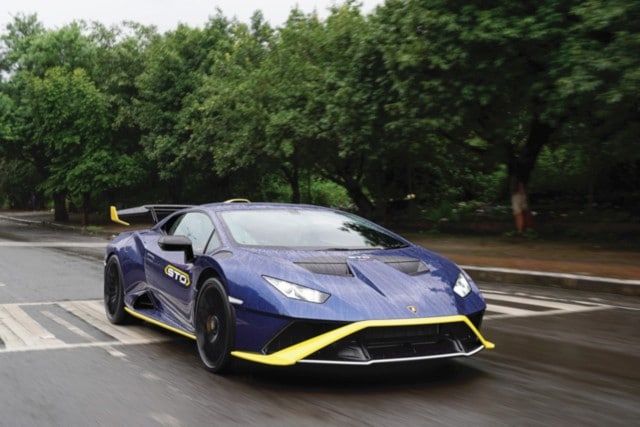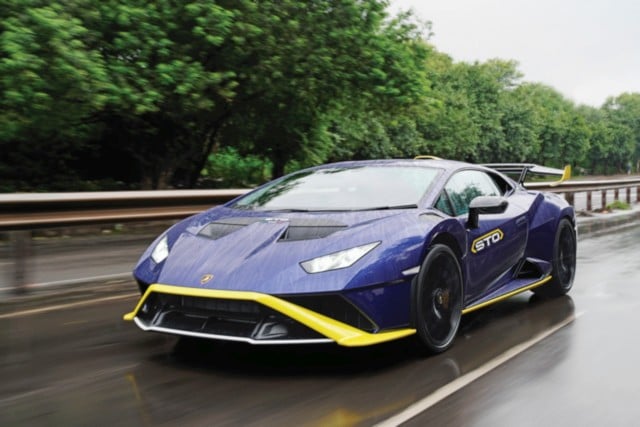The Huracan STO is the unfiltered essence of Lamborghini from Sant’Agata poured into a road car.

Story: Jim Gorde
Photography: Sanjay Raikar
The pitter-patter of rain didn’t dull the thunder emanating from the striking blue and yellow winged bull standing low and staring menacingly at the open road ahead. A race car for the road is a special thing. Any time. Any place. Crowds gather. Phones aplenty make clicky sounds. And there’s no disputing it’s a jaw-dropper. No one asks about economy. The questions: ‘How much is it?’ and ‘What’s the duty like on this? Has to be imported…’ Yes. Kids sure know their stuff these days.
So, the Huracan STO, or Super Trofeo Omologata, is the Super Trofeo racing series model homologated for road use. It is like, in Stuttgart cousin terms, the 911 GT3 RS of its range, but with more than 100 additional horsepower. In fact — and this is a crucial bit — it matches the output of the second iteration of Lamborghini’s Murcielago, the LP640-4 that had its 6.5-litre V12 dish out the same power 15 years ago; up from 580-hp 6.2-litre V12 it started out with two decades ago. That is a significant leap for the V10. Also, this Huracan, if they’d stuck to the nomenclature, would be an LP640-2! This seemingly Huracan EVO-spec motor is essentially in a bespoke state of tune here. It makes the same 640 hp but the torque is five Nm up on the EVO RWD models though still down 35 Nm on the four-wheel-drive EVO models, for obvious reasons.
What’s more, with the high-revving V10 driving only the rear wheels through the Lamborghini doppia frizione (Italian for Lambo double-clutch) means it weighs in at 1,339 kilograms, 43 kg less than the Huracan Performante, and boasts of 478 hp/tonne. And the weight distribution is a sweet 41:59; putting its mass down on the thick 305-sec Bridgestone Potenza low-profile, high-performance rubber. The low weight is mostly down to the extensive use of carbon-fibre — for more than 75 per cent components and panels — from the hybrid carbon-aluminium chassis to brakes and aero elements, particularly that three-step rear wing. The STO is the result of the meeting of the minds with Lamborghini’s R&D, Squadra Corse, and Centro Stile divisions working every line and feature to optimize them for the best driving performance. The rear fender, for example, has a carbon-fibre “sandwich” technique, utilized in the aerospace industry, and uses a quarter less material while maintaining the same structural rigidity. It’s not just that. The magnesium wheel rims and carbon brakes reduce unsprung weight. The door-locks are replaced with fabric loops. Even the windscreen weighs a fifth less than that of the Performante.
The styling isn’t the love-it-or-hate-it kind; Lambo don’t really do those. Rather, it’s the typically Lamborghini stunning and bold you-will-like-it variety. And there are only a limited few up for grabs. Homologated race cars and Italians have an enviable history, there’s no denying that. And, to go with their flair and dynamic stance, there’s the added factor of exclusivity. The STO has elements that make it a special beast indeed; primarily, the two-tone yellow on blue paint finish. The carbon elements — front splitter, louvres, roof scoop, rear wing, and diffuser — stand out and give it the essential awe-inspiring touches. The car is easy to take apart for service, too! Cue the centre-locking wheel-nuts, twist-lock engine cover and the cofango (discussed later).
New air ducts on the front bonnet increase the airflow through the central radiator to improve engine cooling as well as helping generate downforce. The cofango also incorporates a new front splitter, directing airflow to the newly designed underbody of the car and to the rear diffuser. This pushes the airflow over the front fenders with their louvres maximizing airflow from the wheelhouse. This helps reduce pressure inside, thereby increasing front downforce. The side profile of the cofango directs airflow around the front wheels, reducing drag.





















Leave a Reply